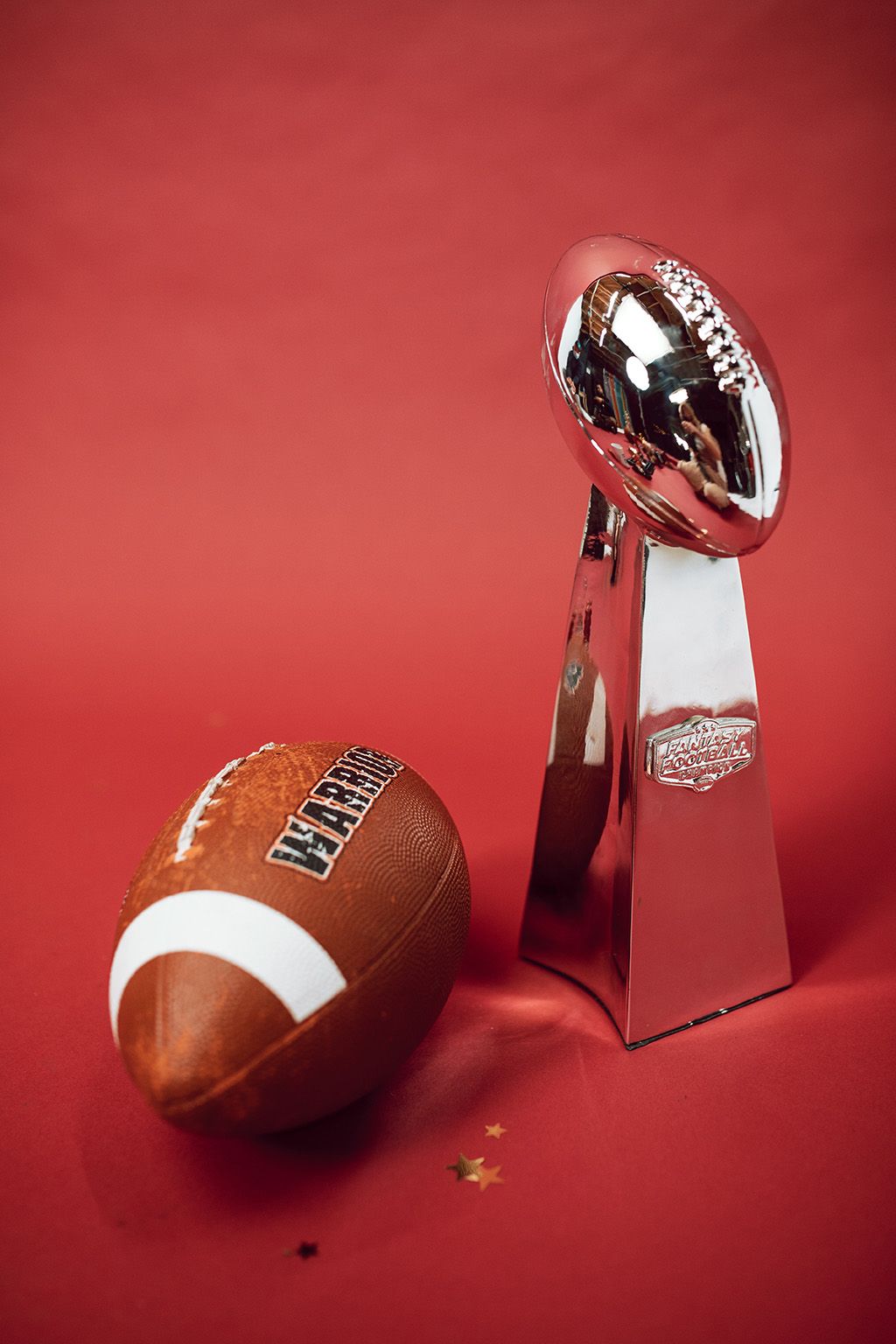
Memorials are traditionally a special object that is used to remember and honor the life of a person who has passed away. While most memorials look closer to the type we provide across our site, the truth is memorials can be anything from engraved plaques to location landmarks, even larger than life statues.
In the sports world, when an athlete does something historic they're often memorialized in a variety of ways. Special items like statues outside of stadiums, busts in Hall of Fame buildings, buildings and streets that bear their name, and even Retired numbers.
If you were good, maybe you will get your name added to your NFL or college team's "ring of honor." If you were great, maybe you will get your number retired. But if you're exceptional, that's where the real legacy starts - and it's often remembered with statues, Hall of Fame exhibits, and, in the case of the first member of this list, the sport of football's most coveted trophy.
There are plenty of ways to remember people, and in the case of some of the most recognized and honored names in National Football League history, there were many people who they may have brought joy to throughout their careers. While some of the locations and objects we cover from our list below From Vince Lombardi to Peyton Manning to Tom Landy, here's a look at where to visit if you want to pay tribute to and remember some of the NFL's greats.


Vince Lombardi
Arguably the greatest head coach in NFL history, Vince Lombardi is best known for his time spent coaching the Green Bay Packers in the 1960s, when he led the squad to a whooping five NFL titles in seven years - and that's not including the first two Super Bowls after the game was created to crown an NFL champion in 1966. Lombardi never had a team with a losing season in the NFL, amassing a regular season record of 96-34-6 and a 9-1 postseason mark. Known for his attention to detail, leadership and fiery temper, Lombardi got the most out of the teams he coached, as evidenced by his career record.
At the time Lombardi coached, a color barrier still existed in sports, notably in the NFL. Lombardi operated with an anti-discrimination policy and instead wanted the best players, regardless of the color of their skin. When Lombardi began coaching the Packers, they only had one black player. By 1967, the team had 13. Lombardi's stance was unusual at the time, and he went so far as threatening to kick players off the team if they showed prejudice in any way and threatening Green Bay establishments as off limits to the entire team if they didn't serve all of his players. He was known for seeing everyone as equals and treating everyone with respect - something he demanded from his players as well.
Lombardi passed away in 1970.
Where to Find Vince Lombardi's Memorial
There may not be another person more celebrated than Vince Lombardi in football. A 14-foot statue stands outside of the Green Bay Packers' Lambeau Field to honor his legacy and the impact he made on the organization during his coaching days.
The trophy that the Super Bowl winning team receives every year is coined the "Lombardi Trophy" in his honor. And you can also pay tribute to Lombardi in various Halls of Fame. He was posthumously inducted into the NFL Hall of Fame in 1971 and the Wisconsin Athletic Hall of Fame in 1976. One of the middle schools in the Green Bay School District is named "Lombardi Middle School." And despite only spending a short time as coach of the then-Washington Redskins, he was placed in the club's ring of honor.
Walter Payton
Many consider former Chicago Bears running back Walter Payton as not only the best running back to ever play the game, but the best football player in general to ever lace up the cleats and take to the gridiron. And for how good his play on the field was, he was also considered to be an exceptional person off of it as well.
Let's start with Payton's on-field play. Drafted by the Chicago Bears after playing his college ball at Jackson State University, Payton amassed incredible numbers throughout his 12-year NFL career. He rushed for nearly 17,000 yards and 110 rushing touchdowns. But his versatility also made him a receiving threat, as he snagged nearly 500 receptions for more than 4,500 total yards and 15 touchdowns as well. In fact, he once held the NFL record for career rushing yards, touchdowns, yards from scrimmage and all-purpose yards. Payton was so versatile on the field that he even threw eight touchdown passes. His accolades included being named the NFL MVP in 1977, nine selections to the Pro Bowl All-Star team and being a five-time first-team All-Pro. But none of these individual accomplishments were as significant as the one Payton achieved with his team when the Bears won the 1985 Super Bowl.
Payton was very humble, both on and off the field. After scoring touchdowns, he would often decline to celebrate - instead just flipping the ball to the official or a teammate. Off the field, he married Connie Norwood in 1976 and had two children, Jarrett and Brittney. He died at the age of 45 from bile duct cancer that was believed to have been caused by a rare liver disease, primary sclerosing cholangitis. His legacy lives on through the Walter and Connie Payton Foundation, which helps bring more attention to the need for organ donations. He also lives on through many of today's NFL running backs, who cite him as an inspiration.
Where to Find Walter Payton's Memorial
Walter Payton's memory lives on in several ways, both in and around Soldier Field, where the Bears continue to play their home games, as well as the city of Chicago, his adopted home. You can find the Walter Payton statue outside Gate 0 at Soldier Field on the stadium's south side. The 12-foot, 3,000-pound statue was unveiled in 2019. Inside Soldier Field, his No. 34 is retired and on display. (His bust is also on display in the Pro Football Hall of Fame in Canton, Ohio, following his induction in 1993.)
There are various other memorials throughout the city of Chicago and the surrounding area. U.S. Route 34 in Illinois is named "Walter Payton Memorial Highway," and Nickol Knoll Hill, where Payton often trained, was renamed "Payton's Hill."
John Madden
John Madden was known for his quirky sideline antics and fiery spirit when he coached the Oakland Raiders to seven division titles, eight playoff appearances, one Super Bowl victory and zero losing seasons from 1969-1978. In fact, his 112-39-7 record and .731 winning percentage is still a coaching record among head coaches who have coached in at least 100 games. But Madden is perhaps best known for his broadcasting career after hanging up his whistle and stepping away from coaching at the young age of 42. Madden worked for every major network that televised NFL football, beginning with CBS, then Fox Sports, then ABC and finally, NBC, before his retirement in 2008.
Madden had a larger-than-life personality and quickly became part of the No. 1 broadcast team on every network that he worked for. Known for his catch phrases and analysis from a coach's perspective, Madden was beloved by NFL fans and players. He named players annually to the "All-Madden Team," an all-star team of sorts that Madden claimed was comprised of players who "play football the way it's meant to be played." He made the term "turducken" a household name. And he instilled football in future generations with the Madden NFL Football video game series beginning in 1988.
Known for his kindness and for always taking time with fans, he traveled the country to his assignments throughout his broadcasting career on the "Madden Cruiser" RV bus, which logged about 80,000 miles a year. A 12-time Emmy winner for his broadcasting prowess, Madden passed away at his home in California at the age of 85 in late 2021.
Where to Find John Madden's Memorial
Madden's legacy lives on not just through his Madden NFL Football video games, but inside the walls of the Pro Football Hall of Fame in Canton, Ohio. Madden was inducted into the Hall of Fame in 2006 - and it's not just his bust that lives there, but his famed Madden Cruiser, which was donated to the Hall in 2018.
Pat Tillman
Would you give up a promising NFL career to join the U.S. Army? That's exactly what Pat Tillman did in May 2002. With a desire to serve following the September 11, 2001 terrorist attacks, Tillman left the Arizona Cardinals and was deployed to Afghanistan. Sadly, he was killed by friendly fire in 2004 at the age of 27.
Tillman's story is inspirational for many. As an NFL safety, Tillman turned down a multi-million dollar contract to enlist in the U.S. Army. Tillman was known for his progressive views and anti-war stance, electing to join the Army instead to battle the Al-Qaeda terrorist group and bring Osama Bin Laden to justice for the pain he had inflicted on Americans.


Where to Find Pat Tillman's Memorial
There are countless memorials of Pat Tillman. His No. 40 jersey was retired by the Arizona Cardinals and his name is in the franchise's "ring of honor." A bronze statue outside of State Farm Stadium in Glendale, Arizona was unveiled in 2006. The 8-foot bronze statue is open to the public and bordered by a reflecting pond.
His No. 42 was also retired by the Arizona State Sun Devils, where he played his college football. The PAC-10's Defensive Player of the Year Aweard is named in Tillman's honor. Another statue of Tillman is located in front of the Tillman Tunnel at Sun Devil Stadium. The Tillman Tunnel is where the Sun Devils take to the field at home football games.
His widow, Marie, formed the Pat Tillman Foundation to help support positive change in the world. A highway bypass near Hoover Dam carries his name. The Pat Tillman USO Center was opened on Bagram Air Base in Afghanistan in 2005.
Red Grange
If there was one player to legitimize the National Football League shortly after its forming, that one player might as well be Harold Edward "Red" Grange. Also known as "The Galloping Ghost" and "The Wheaton Iceman," Grange was a star running back at the University of Illinois in the 1902s, leading the Fighting Illini to a 1923 National Championship. In college, Grange was a three-time consensus All-American.
But it was what Grange did after college that arguably cemented his legacy and helped pave the way for the NFL as we know it today. When he joined the Chicago Bears in 1925, it helped bring necessary attention to the NFL and legitimize the league. Attendance to games grew and Grange was said to have saved professional football. His professional playing career ended in 1934, but he stayed on with the Bears as a coach for an additional three seasons. Grange was the first football player to ever appear on a box of Wheaties in 1935 and he also appeared on the cover of Time Magazine during his playing days.
After football, Grange dabbled in acting and eventually worked as a motivational speaker and a sports announcer. He passed away in 1991.
Where to Find Red Grange's Memorial
Grange's legacy lives on in many ways. His accolades are numerous, and perhaps the most significant one is his No. 1 ranking on ESPN's Top 25 Players in College Football History list, which was released in 2008. At the University of Illinois, a one-ton, 12-foot statue stands outside Memorial Stadium to honor Grange and his accomplishments while playing college football for the university. The statue was dedicated in 2009. His No. 77 has also been retired by the University of Illinois. Additionally, Grange is a charter member of both the College Football Hall of Fame and the Pro Football Hall of Fame.
Bubba Smith
Charles Smith, better known as just "Bubba Smith," was an accomplished athlete and actor - but the most significant aspect of his legacy is how he helped with integration in college football in 1960s. A Texas native, Smith originally wanted to play his college ball for the Texas Longhorns. But he was never offered a scholarship, largely due to the ongoing racial segregation still taking place in the south and the Southwest Conference, the conference the University of Texas played in at the time. He was afforded an opportunity at Michigan State University, where he played a starring role. Known for his ruthless play on the field, Bubba was a two-time All-American in 1965 and 1966. He was the No. 1 pick in the 1967 NFL Draft and played nine seasons in the NFL.
After retiring from football, Bubba Smith became a well-known actor in both TV and films. He was best known for playing the character of Moses Hightower in the first six Police Academy movies. Smith passed away at his Los Angeles home in 2011 at the age of 66.
Where to Find Bubba Smith's Memorial
You can find tributes to Bubba Smith in multiple places throughout the country. One is Spartan Stadium in East Lansing, Michigan - the home field of the Michigan State Spartans football team. Smith is enshrined in the Spartans' ring of honor inside the stadium. Smith's No. 95 was also retired by the Spartans, which took place in a ceremony in September of 2006 to honor the 40th anniversary of "The Game of the Century," - Smith's last game as a Spartan in 1966, a 10-10 tie versus Notre Dame. Smith is also a 1988 inductee of the College Football Hall of Fame.
Smith's story is also featured in the documentary film, "Through the Banks of the Red Cedar," which tells the story of how Michigan State and Bubba Smith helped pave the way for integration in college sports. Michigan State has publicly stated that it is currently planning more initiatives to honor it - and Smith - as trailblazers in the integration movement in the near future.
Tom Landry
The first head coach of the NFL's Dallas Cowboys, Tom Landry was also arguably the most legendary of all Cowboy coaches. Known for his defensive prowess and the introduction of many new, unique formations - including the now-popular 4-3 defensive format - Landry posted 20 straight winning seasons, won a pair of Super Bowls and led the Cowboys to an astounding 13 divisional titles. Landry's consistency and successful track record helped make Dallas one of the most beloved franchises in the NFL, earning it the moniker, "America's Team."
Landry's success aside, he was perhaps best known for modernizing football - specifically defensive scheming - into what we now know today. He was dubbed "The Great Innovator" for his progressive defensive schemes. He was also among the first coaches that would look internationally for talent, as he was known to recruit Latin American soccer players to the kicker position on the Cowboys. He would often recruit track and field athletes to play skills positions, such as Bob Hayes - once known as the "fastest man in the world." Landry also grew and developed other coaches. Some of the notable would-be NFL head coaches that once coached under Landry include Mike Ditka and Dan Reeves.
Landry passed away in 2000.
Where to Find Tom Landry's Memorial
Landry is a 1990 inductee of the Pro Football Hall of Fame, and his bust is on display in Canton, Ohio. Three years later, he was inducted into the Cowboy's ring of honor. A statue of Landry was also erected outside of AT&T Stadium, where Dallas plays its home games, depicting him in his suit and fedora - his standard outfit when patrolling the Cowboys sidelines.
Finally, Landry's legacy also lives on in any team that plays a 4-3 defensive scheme, which is the majority of college and NFL teams these days.
Other NFL Greats
Peyton Manning
With still today, Manning can be seen on ESPN2 yucking it up with his brother, Eli, during the "Manningcast" - a complimentary feature to the conventional Monday Night Football broadcast. But not too long ago, Peyton Manning was regularly leading the Indianapolis Colts and, eventually, the Denver Broncos to Super Bowl victories. Over his 18-year NFL career, Manning won five NFL MVP awards, was a seven-time First Team All-Pro, went to 14 Pro Bowls and holds several NFL records, including most passing touchdowns in a single season (55), most passing yards in a single season (5,477) and most game-winning drives (54). Manning led his teams to three Super Bowls, winning two - one with the Colts and the other with the Broncos. Manning retired after the Denver Broncos won the Super Bowl in 2015.
Noted for his preparation, intensity and his ability to correctly audible out of called plays at the line of scrimmage, Manning will go down as one of the greatest quarterbacks to ever play football. Manning also began a charity, the Peyback Foundation, which helps disadvantaged children.
Dan Marino
Dan Marino, like Manning, is another great Hall of Famer we couldn't leave out. He never won a Super Bowl, but what he meant to the Miami Dolphins franchise over his 17 years with the organization is immeasurable. His quick release and strong arm helped him rack up plenty of accolades, and while many of his once-all-time records have since been broken, Marino is still considered one of the top 10 quarterbacks of all time.
Dan Marino was inducted into the College Football Hall of Fame in 2003 and the Pro Football Hall of Fame in 2005. He's one of only three Dolphins players with their jersey retired. A statue honoring Marino also stands at Sun Life Stadium outside of where the Dolphins play. Today, Marino is still involved with the Dolphins, serving as a special advisor.
Art Rooney
Art Rooney didn't play football, but his impact on the game was incredible. As the founding owner of the Pittsburgh Steelers, he was a mentor to other NFL owners and helped make the league what it has become today. The Steelers franchise is still owned by the Rooney family today. A statue honoring Rooney stands outside of the Steelers' current home stadium, Heinz Field. Rooney was also inducted into the Pro Football Hall of Fame.


Every year we wrap up one of the most cherished sports in our country with the big Superbowl Sunday championship game. A sport that has grown into not only becoming the most watched event in the US every year, but one of which has created legends and career legacies for both athletes and coaches in American history. If you ever have an opportunity to to visit any of these locations, be sure to visit the memorials placed in their honor.





